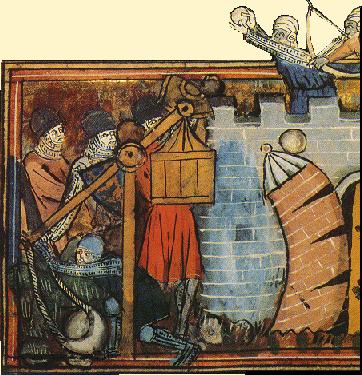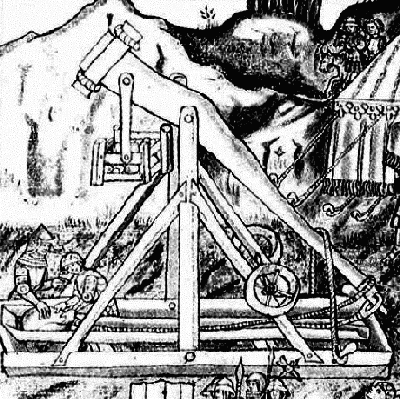
|
Part 4 |

|
Part 4 |
|
This is one of a series of pages of
Medieval and Renaissance illustrations of trebuchets. To avoid problems
with historical interpretation (& copyright!) as much as possible,
I have chosen to use pictures which seem to be plausibly contemporary
with the devices being illustrated. I have also tried to avoid what
seem to be obvious fantasy pieces. . |
| No. 13 - Roman de Godefrey de Bouillon |

The lays of the rope sling cords are clearly and carefully shown, making the plain cloth-like appearance of the pouch itself more significant. (Of course, the pouch could be supposed to be any other suitable smooth material, such as leather.)
Although artistic composition may partly demand it, it's interesting that here again the trebuchet is drawn close to the walls (and in range of the defenders). Does the crewman have a worried expression drawn on his face.?
Just to bring these thoughts back to earth, note that this drawing has
the usual Medieval perspective - important people are as tall as city
walls and action gets telescoped (The trebuchet is about to fire, while
at the same time a stone crashes down onto a gate tower... and of
course if you decided to accept this drawing literally then the entire
scene would fit into a modest living room.)
| No. 14 - "Unidentified picture.. " |

The strong joinery used in trebuchet frames is hinted at here, as it is in Illustration No. 4.
This drawing also clearly shows the sling release prong on the end of the beam - here obviously a separate component.
I have no idea what the object on the weight end of the beam is. It appears to be held on with rope. I can only guess that it is an additional weight. If so it would make this machine unusual in having both freely swinging ballast in the bucket and rigidly attached weight on the beam.
A picture of a Middle Eastern machine shown in Illustration No.21 also seems to have this apparent dual-weight system.
(This might do strange things to the way that the weight bucket swung.
Since the mass of the beam vs that of the hanging bucket will effect
the momentum of the beam and hence the position in which the beam
"stalls" - decellerates or even comes to a brief pause as the bucket's
fall hits bottom- it would also effect the timing and angle of the
sling release. ie it could be a form of tuning for adjusting range.)
| No. 15 - "The Power of Love" |

I won't go any further into the symbolism of this except to point out that they are throwing flowers at one another. In the case of the men's trebuchet it is a basket of flowers - an entirely sweeter version of the ugly basket of heads seen being thrown in Illustration No.7
Although the decoration on the ladder standing up by itself against the wall is disconcertingly rope-like, it's worth noting the way the trebuchet sling is carved as if woven from cords.
(Illustration 15 by courtesy of The University of Illinois)
| No. 16 - Renatus |

This drawing shows the uprights of the frame rising vertically and then angling steeply at the top. Certainly many other drawings show or appear to show inward-sloping uprights (such as Illustration No.4), but this picture shows this inward slope achieved by some weak and unsupported joints. This structure might well be practical using welded tube steel - but timber??
Other than this quibble and the lack of side bracing timbers, the drawing shows all the features listed in earlier illustrations: the launch trough, the fore-and-aft bracing of the uprights, the winch gear worked by wheels with hand-holds, and a sling with cords shown attached to the beam at one end and a loop on a release prong on the other.
Another feature of this drawing is the practical detail of the
counterweight, here a blob (possibly of earth) held in place on the end
of the beam with cloth and rope.

NOTE: Although trebuchets were reported to have been used into what we might think of as Renaissance times (such as the siege of Burgos in 1475/76 , where both bombards and trebuchets were used ... or Cortez's campaign against the Aztecs in 1517) many of the siege engine drawings available are from even later military treatises.
Some
of the drawings that accompany those of the trebuchets (such as this
drawing to the right)seem fanciful-looking enough to sound a note of
caution. ("De re militaria", Valturio, 1472)
| - NAVIGATION -
|
||||
|---|---|---|---|---|
 |
||||
 |
Previous | Next |  |
|
| Page |
|
Page | ||
